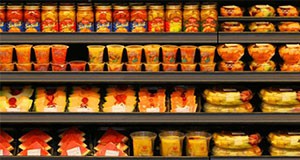 In competitive markets, innovations such as electronic devices, information technology, and green and sustainable technologies can provide a competitive advantage in managing the supply chain, and determine which operations succeed and which fail. The information in this article is intended to provide insight regarding the potential benefits and limitations of these technologies so that firms in the food industry can make more informed decisions on which technologies should be incorporated into their own systems and to what degree. This 5-page fact sheet was written by Jonathan A. Watson, Allen F. Wysocki, and Ray A. Bucklin, and published by the UF Department of Agricultural and Biological Engineering, April 2015. (UF/IFAS photo: Thomas Wright)
In competitive markets, innovations such as electronic devices, information technology, and green and sustainable technologies can provide a competitive advantage in managing the supply chain, and determine which operations succeed and which fail. The information in this article is intended to provide insight regarding the potential benefits and limitations of these technologies so that firms in the food industry can make more informed decisions on which technologies should be incorporated into their own systems and to what degree. This 5-page fact sheet was written by Jonathan A. Watson, Allen F. Wysocki, and Ray A. Bucklin, and published by the UF Department of Agricultural and Biological Engineering, April 2015. (UF/IFAS photo: Thomas Wright)
http://edis.ifas.ufl.edu/ae511
Tag: Allen F. Wysocki
Costos Estimados en el 2010 para Establecer y Producir Pitaya (Fruta Dragón) en el Sur de Florida (FE921)
 Como consecuencia de la creciente competencia extranjera y la disminución de rendimientos de los productos agrícolas tradicionales, muchos productores en el Sur de la Florida se han embarcado en una búsqueda agresiva de productos agrícolas que sean alternativas viables. Un producto que ha llamado la atención es la pitaya, una especie de cactus trepador autóctona de las regiones de bosques tropicales de México, Centroamérica y América del Sur. De menos de 50 hectáreas plantadas en la Florida en fecha tan reciente como 2006, la producción se ha multiplicado por seis y ahora se estima en alrededor de 320 acres. This 6-page fact sheet was written by Edward A. Evans, Jordan Huntley, Jonathan Crane, and Allen F. Wysocki, and published by the UF Department of Food and Resource Economics, March 2013.
Como consecuencia de la creciente competencia extranjera y la disminución de rendimientos de los productos agrícolas tradicionales, muchos productores en el Sur de la Florida se han embarcado en una búsqueda agresiva de productos agrícolas que sean alternativas viables. Un producto que ha llamado la atención es la pitaya, una especie de cactus trepador autóctona de las regiones de bosques tropicales de México, Centroamérica y América del Sur. De menos de 50 hectáreas plantadas en la Florida en fecha tan reciente como 2006, la producción se ha multiplicado por seis y ahora se estima en alrededor de 320 acres. This 6-page fact sheet was written by Edward A. Evans, Jordan Huntley, Jonathan Crane, and Allen F. Wysocki, and published by the UF Department of Food and Resource Economics, March 2013.
http://edis.ifas.ufl.edu/fe921
Leadership Principles for Today’s Residential Real Estate Brokers (HR029)
Despite the turmoil and dying nature of the residential brokerage industry, there exists a hidden opportunity for those real estate brokers who are willing to implement the leadership principles discussed herein to effectively build, grow, and sustain a new residential real estate brokerage business model. This 7-page fact sheet was written by Aarambh Shah and Allen Wysocki, and published by the UF Department of Food and Resource Economics , May 2011.
http://edis.ifas.ufl.edu/hr029
Marketing Processed Agricultural Products in Florida: Steps to Take (FCS8941/FY1225)
Fruits, vegetables, and other agricultural commodities that are processed, bottled, or packaged for human consumption must be prepared in accordance with statutes enacted by the Florida Legislature and rules administered by the Florida Department of Agriculture and Consumer Services (FDACS). This 6-page fact sheet helps producers understand the rules governing direct marketing in Florida. Written by Bradley J. Burbaugh, Elena Toro, Amarat H. Simonne, Keith R. Schneider, Renée M. Goodrich-Schneider, Allen F. Wysocki, Arthur A. Teixeira, and John T. Fruin, and published by the UF Department of Family Youth and Community Sciences, March 2011.
http://edis.ifas.ufl.edu/fy1225
FE888 2010 Cost Estimates of Establishing and Producing Pitaya (Dragon Fruit) in South Florida
FE888, a 7-page fact sheet by Edward A. Evans, Jordan Huntley, Jonathan Crane, and Allen F. Wysocki, provides needed information on the costs and returns associated with establishing and operating a five-acre pitaya orchard in South Florida, and assesses the prices and yields that must be obtained to make the establishment and production of a pitaya orchard a profitable venture. Published by the UF Department of Food and Resource Economics, December 2010.
http://edis.ifas.ufl.edu/fe888
FE828 Complying with Regulations to Sell Farm Fresh Eggs
FE828, a 4-page illustrated fact sheet by Brad Burbaugh, Elena Toro, Linda Landrum, George Harrison, John Fruin, and Allen Wysocki, provides an overview of the steps necessary to comply with Florida’s existing regulations for selling eggs which are overseen by FDACS. Published by the UF Department of Food and Resource Economics, February 2010.
http://edis.ifas.ufl.edu/fe828
HR028 Sexual Harassment in the Information Age: The Human Resource Manager’s Guide to Nontraditional Sexual Harassment
HR028, a 4-page fact sheet by Angelina C. Toomey and Allen F. Wysocki, helps human resource managers recognize types of nontraditional sexual harassment and strategies managers can take to ensure a workplace that is free from all types of harassment or prejudicial treatment. Includes references. Published by the UF Department of Food and Resource Economics, December 2009.
http://edis.ifas.ufl.edu/HR028
FE820 Distinguishing between Traditional and Online Retailing: Evaluating E-commerce with Respect to the Food System
FE820, a 4-page fact sheet by Angelina C. Toomey and Allen F. Wysocki, focuses on business-to-consumer (B2C) practices, and in particular, B2C methods of e-commerce with respect to online food sales. Includes references. Published by the UF Department of Food and Resource Economics, December 2009.
http://edis.ifas.ufl.edu/FE820
FE821 Seafood Perceptions among People Aged 55 and Above: Summary of Focus Groups Results
FE821, a 6-page fact sheet by Allen F. Wysocki, Lisa House, and William A. Messina, Jr., provides a brief summary of the focus group part of a study of perceptions of Florida residents aged 55 and over on seafood consumption. Published by the UF Department of Food and Resource Economics, November 2009.
http://edis.ifas.ufl.edu/FE821
HR027/HR027 Empowering Kennel Associates at Veterinary Practices: Win-Win Strategies for Management and Employees
HR027, a 6-page fact sheet by Jennifer E. Darby and Allen F. Wysocki, outlines what it takes to create a positive work environment through effective communication, encouragement, rewards, training, and goal setting. Includes references. Published by the UF Department of Food and Resource Economics, April 2008.
http://edis.ifas.ufl.edu/HR027